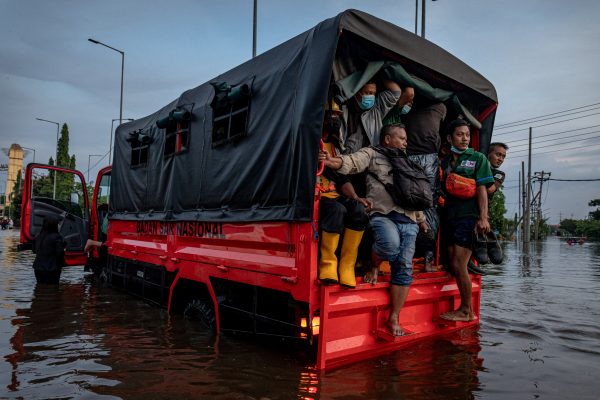Across Indonesia, 63 million people live in flood-prone areas. One of the most vulnerable nations to climate change, Indonesia is experiencing increasingly unpredictable monsoon seasons marked by higher precipitation. Indonesia’s Meteorology, Climatology and Geophysical Agency anticipates that Indonesia will likely experience high rain precipitation in 2023 as climate change drives flooding and other hydrometeorological events.
The good news is that disaster management is already an established priority for the government. The devastating 2004 Aceh tsunami exposed shortcomings in Indonesia’s approach to disaster management and prompted a transition from disaster response to disaster risk reduction. The National Agency for Disaster Management was established in 2008 to coordinate and implement disaster management across Indonesia in collaboration with the Regional Agencies for Disaster Management.
Indonesia has developed a robust infrastructural and institutional framework for disaster risk management. The National Agency for Disaster Management develops the national scale disaster management plans, including the Master Plan for Disaster Management 2020–2044. Disaster risk reduction is also integrated into national development planning and Indonesia has invested in early warning systems.
In 2022, two new programs — InAWARE and the Disaster Monitoring and Response System — were launched to ‘support hazard monitoring, disaster response, regional cooperation and early warning’. A challenge for Indonesia has been developing the capacity of regional agencies. These investments by the government in forecasting technologies, research and human resources will help build the institutional capacity of regional agencies and their ability to prepare for floods.
Indonesia’s disaster management efforts are largely funded by the national budget and international assistance. But the annual budget for disasters from 2005 to 2017 was just Rp 3.1 trillion (US$219 million), leaving an estimated post-disaster funding gap of Rp 19.75 trillion (US$1.4 billion). The Indonesian government has turned to private sector finance to close this gap. This move aligns with the UN Sendai Framework for Disaster Risk Reduction 2015–2030, which identifies ‘investing in disaster reduction for resilience’ as one of four strategic priorities.
The government has begun to insure national assets and, in 2021, established a Rp 7.3 trillion (US$500 million) Disaster Pooling Fund with a loan from the World Bank. Indonesian Finance Minister Sri Mulyani Indrawati says that private capital will free up funding from the national budget for ‘other priority sectors’, including health and education. Making additional funding available for transportation and communications infrastructure would also benefit disaster risk reduction efforts in Indonesia given its unique geographical challenges as an archipelago more than 5000 kilometres long and comprising over 17,000 islands.
For several years, Indonesia has also been considering issuing catastrophe bonds, a tool promoted by the World Bank to transfer risk to the private capital market. Typically, catastrophe bonds include a parametric trigger, meaning that payouts are only made when the catastrophe meets particular criteria, such as falling within a geographically-bounded area.
Catastrophe bonds tend to only protect against large-scale disasters, and not more common, smaller-scale disasters. Plus, as climate change makes predicting future events more challenging, there is a risk that the models used to develop parametric triggers are wrong. This could mean that the disasters that actually occur do not trigger payouts, as was the case for the 2016 drought in Malawi.
While risk pooling and other insurance-linked security instruments can ensure liquidity in the wake of a disaster, they do nothing to reduce the risk of disaster in the first place. Neither do they necessarily assist the most vulnerable communities or reduce their vulnerability to disasters. The World Bank portrays risk pooling as an instrument that protects the vulnerable and poor, though the evidence for this is mixed.
Jakarta offers a cautionary tale. The city’s flood mitigation plans have often put poor residents at greater risk. Not only have households been subject to forced eviction, but the city has previously refused to grant compensation, maintaining that citizens did not have legal access to or ownership of the land they occupied. This treatment of the urban poor raises questions about how payouts would be used in the wake of a disaster. Integrating a pro-poor mandate into the risk pool and putting in place measures to track how payouts are spent could help to ensure that the most vulnerable people receive assistance.
The bottom line is that risk pooling, catastrophe bonds and other financial instruments do not render disaster or climate mitigation efforts any less vital and cannot be a substitute for public sector investment in pro-poor disaster risk reduction and implementation of measures to ensure vulnerable populations receive relief and support in the wake of disastrous flooding.
Emma Colven is Assistant Professor of Global Environment at the University of Oklahoma.

